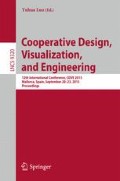Abstract
In this paper, an approach based on the Pareto front theory is employed to conduct the multi-objective optimization of the global stiffness and well-conditioned workspace of 3UPU-UPU parallel mechanism. The inverse kinematic and Jacobian matrix of the 3UPU-UPU mechanism are first calculated. Then the stiffness model of the mechanism is derived and the sum of the diagonal elements of the stiffness matrix is used as a criterion to evaluate the global stiffness. Secondly, the Monte Carlo method is used to derive the global condition index of the mechanism which later is used as a criterion to evaluate the well-conditioned workspace of the mechanism. Normally, increasing the workspace of the mechanism will deteriorate the stiffness, here the global stiffness and well-conditioned workspace of the mechanism are optimized simultaneously based on the Pareto front theory, and the optimized results are displayed and compared.
Access this chapter
Tax calculation will be finalised at checkout
Purchases are for personal use only
References
Zhang, D., Bi, Z.M., Li, B.Z.: Design and kinetostatic analysis of a new parallel manipulator. Robot. Comput. Integr. Manuf. 25, 782–791 (2009)
Zhang, D., Gao, Z., Fassi, I.: Design optimization of a spatial hybrid mechanism for micromanipulation. Int. J. Mech. Mater. Des. 7, 55–70 (2011)
Gorie, N., Dolga, V., Biomechatronics recovery systems for persons with disabilities. In: Proceedings of International Conference on Innovations, Recent Trends and Challenges in Mechatronics, Mechanical Engineering and New High-Tech Products Development –MECAHITECH 2011, vol. 3 (2011)
Castelli, G., Ottaviano, E.: Modelling, simulation and testing of a reconfigurable cable-based parallel manipulator as motion aiding system. Appl. Bion. Biomech. 7(4), 253–268 (2010)
Castelli, G., Ottaviano, E.: Modeling and simulation of a cable based parallel manipulator as an assisting device. In: Computational Kinematics: Proceedings of the 5th International Workshop on Computational Kinematics. Springer, pp. 17–24 (2010)
Pan, M.: Improved design of a three-degree of freedom hip exoskeleton based on biomimetic parallel structure. Master Thesis, University of Ontario Institute of Technology, Canada (2011)
Huang, X.G., He, G.P., Tan, X.L.: An introduction to parallel robot mechanism. J. North China Univ. Technol. 27(3), 25–31 (2009)
Yu, H.J.: Research on parallel robot based flexible fixtures for automotive sheet metal assembly. PhD thesis, Harbin Institute of Technology (2010)
Zhang, Y.W., Wei, B., Wang, N.: Kinematic performance analysis of 3-SPS-S spatial rotation parallel mechanism. Trans. Chin. Soc. Agri. Mach. 43(4), 212–215 (2012)
Zhang, D., Gao, Z.: Hybrid head mechanism of the groundhog-like mine rescue robot. Robot. Comput. Integr. Manuf. 27, 460–470 (2011)
Konak, A., Coit, D.W., Smith, A.E.: Multi-objective optimization using genetic algorithms: a tutorial. Reliab. Eng. Syst. Saf. 91, 992–1007 (2006)
Gao, Z.: Spatial three degree-of-freedom parallel mechanisms: configurations, performances and applications. PhD thesis, University of Science and Technology of China (2009)
Zhang, D., Gao, Z.: Forward kinematics, performance analysis, and multi-objective optimization of a bio-inspired parallel manipulator. Robot. Comput. Integr. Manuf. 28(4), 484–492 (2012)
Lara-Molina, F.A., Rosario, J.M., Dumur, D.: Multi-objective design of parallel manipulator using global indices. Open Mech. Eng. J. 4, 37–47 (2010)
Zhang, D.: Parallel Robotic Machine Tools. Springer, Berlin (2009)
Hu, X.L.: Design and analysis of a three degrees of freedom parallel kinematic machine. Master thesis. University of Ontario Institute of Technology (2008)
Stamper, R.E., Tsai, L.W., Walsh, G.C.: Optimization of a three DOF translational platform for well-conditioned workspace. In: Proceedings of the IEEE International Conference on Robotics and Automation. New Mexico, pp. 3250–3255 (1997)
Acknowledgements
The authors would like to gratefully acknowledge the financial support from the Natural Sciences and Engineering Research Council of Canada (NSERC) and Canada Research Chairs program.
Author information
Authors and Affiliations
Corresponding author
Editor information
Editors and Affiliations
Rights and permissions
Copyright information
© 2015 Springer International Publishing Switzerland
About this paper
Cite this paper
Zhang, D., Wei, B. (2015). Global Stiffness and Well-Conditioned Workspace Optimization Analysis of 3UPU-UPU Robot Based on Pareto Front Theory. In: Luo, Y. (eds) Cooperative Design, Visualization, and Engineering. CDVE 2015. Lecture Notes in Computer Science(), vol 9320. Springer, Cham. https://doi.org/10.1007/978-3-319-24132-6_15
Download citation
DOI: https://doi.org/10.1007/978-3-319-24132-6_15
Published:
Publisher Name: Springer, Cham
Print ISBN: 978-3-319-24131-9
Online ISBN: 978-3-319-24132-6
eBook Packages: Computer ScienceComputer Science (R0)

